
 Rice
Rice
Savor the freshness of each grain in every bite
Secrets behind delicious Japanese rice: climate, people and technology.
High quality rice is grown throughout Japan.
Rice is a crop that is essential to the Japanese people. Rice-growing began in Japan about 2500 years ago. Japan is located in a temperate zone, blessed with quality water and sunshine and four distinct seasons: all favorable conditions for rice cultivation. The technology to make the most of this environment has progressed thanks to human effort. Presently, all over Japan, rice plants in paddies are neatly planted at equal intervals. Such views form part of the distinctive beauty of the rural Japanese landscape.
 Strict quality control.
Strict quality control.Fir rice growing, farmers have developed cultivation methods that take advantage of Japan's rich natural conditions. At the same time by using weather information and technology such as selective breeding, they have also acquired production techniques that are not easily influenced by external factors. Harvested rice is threshed and kept in cool storage warehouses below 15 oC (59 oF). Then, it is shipped in small quantities to meet consumers' needs. Thus, people can always expect fresh rice to be available in stores.
More than 300 varieties create a wealth of choice.
Japan cultivates an incredible number of rice varieties. National research centers and prefectural experimental stations are producing rice with varying taste by assisting in the development of varieties that suit regional climate, soil and usage. Some varieties are resistant to disease, pests and weather, and others differ in taste, fragrance and texture.
Fluffy cooked rice is a meal on its own. Naturally, it also complements various cuisines.
The rice harvested in Japan is nearly all Japonica rice, which features a natural sweetness, mild fragrance and plump moistness. Being simple and mild, it makes a tasty food on its own and also complements a variety of side dishes. Rice plays a pivotal role in a healthy Japanese diet. Its major constituent is the carbohydrate, but it also contains a good balance of protein, iron, vitamins such as B1 and E, and dietary fiber.
Top Five Types of Japanese Rice in Order of Harvest volume (2007)
|
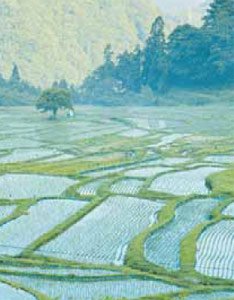 Rice fields in the countryside |
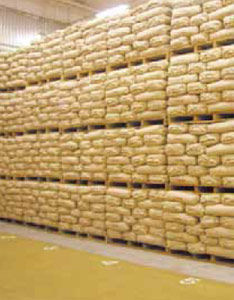 In a cool storage warehouse, temperature can be maintained at below 15 oC (59 oF), even in the summer. |
|
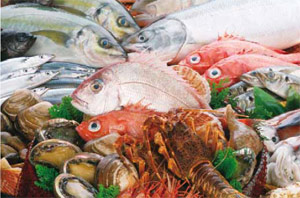 Seafood
Seafood A plentiful source of culinary delight
This gift from the sea is prepared in diverse ways to capture freshness
Japan’s climate and seasons give us a wide variety of delicious fish.
Japan is surrounded by the sea, and the custom of eating fish dates back over 3000 years. Its north-south oriented landmass and its intricate coastline have produced a variety of fish in each region. The rivers that flow through its abundant forests to the sea carry rich nutrients and have nurtured diverse marine products. Fish in season are particularly tasty. For example, spring red sea bream, autumn Pacific saury and winter yellowtail are highly prized in Japanese cuisine.
 |
| With four currents flowing very close to the Japanese archipelago. Its waters are a rich source of fish. |
Warm and cold currents flow around the Japanese archipelago and run into each other along its coast. These locations produce large volumes of plankton, which make them rich fishing grounds by gathering migratory fish. The fish that migrate though these grounds mainly consist of Pacific saury, mackerel, jack mackerel and sardines. These fish species are frequently eaten in Japan, and research has revealed that the nutrients contained in these fish contribute to the long life and good health enjoyed by the Japanese people.
Careful handling techniques allow us to enjoy goodness fresh from the sea.
Japan uses various innovative methods to transport fresh fish. For example, in some cases, coastal catch is carried to port alive in the fishing net under water. Other techniques include keeping the fish alive in a tank and having them move around without being fed, which firms the flesh before processing. Japanese people constantly pursue ways of preparing fish that make it fresher and more delicious to eat.
|
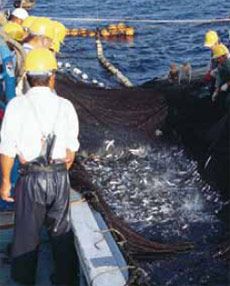 |
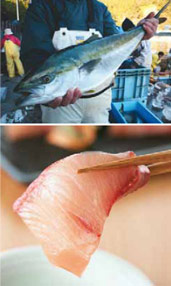 |
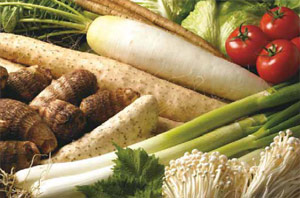 Vegetables
Vegetables Quality derived from nature’s vitality
Humans and nature collaborate to create delicious delights.
Numerous varieties are grown, reflecting Japan’s seasons and climate.
Japan’s natural environment is rich in regional and seasonal changes. Taking advantage of these changes, producers have developed a wide variety of vegetables. Japanese vegetables are succulent with unique tastes. For example, the Japanese daikon radish contains much water and once simmered possesses a subtle depth of flavor. Japanese cuisine has developed by making the most of the various natural flavors of such ingredients.
 |
| Vegetable producing regions are creating beautifully shaped vegetables that can even be enjoyed raw. |
Producers have continued their efforts to produce high quality vegetables through selective breeding and the application of farming methods. Eating vegetables raw has thus become a common practice in Japan, and vegetables like lettuce, tomatoes, cabbage and shallots are firm favorites eaten raw in salads at home. In recent times, their distinctive taste and attractiveness has led to an increasing number of French and Italian chefs who use Japan-grown vegetables.
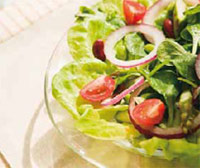 Appropriate controls and methods deliver savory vegetables.
Appropriate controls and methods deliver savory vegetables.The use of agricultural chemicals must meet GAP, which was established by the government. Accordingly, agricultural produce must meet Maximum Residue Limits (MRL) contained in what is called the “Positive List.” In Japan, there is a domestic transportation system that uses temperature control to maintain freshness during distribution. The same know-how is also used when exporting to neighboring countries. Vegetables are packed neatly in boxes with matching sizes to prevent damage during transportation. Other types of GAP are also being adopted throughout Japan’s vegetable growing regions as a system that efficiently manages the production process in consideration of food safety and environmental friendliness.
|
 Simmered Japanese daikon radish. |
Wagyu, Japanese Beef
Luxurious flavor developed with superb skill
 Flavor lovingly nurtured from farm to table.
Flavor lovingly nurtured from farm to table.Technique and care that produce undeniable quality.
Superb wagyu Japanese beef comes from the special technique and the attentive care given by the producers. The term “wagyu beef cattle” refers to distinctive Japanese breeds, Wagyu beef cattle are raised to be healthy animals in well-ventilated barns spread with sawdust. They are fed with a mixture of hay and highly nutritious, safe compound feeds. Farmers who breed wagyu cattle raise them with careful attention to detail as if they were their own children, keeping a close eye on everything, including their physical condition.
 |
| The term wagyu means Japanese Beef cattle, referring to purebreds of four unique breeds: (1) Japanese Black (2) Japanese Shorthorn (3) Japanese Polled (4) Japanese Brown. |
A feature of wagyu beef is melt-in-the-mouth texture and a rich, luxurious taste derived from an abundance of fat. The beautiful pattern of fat through red flesh like the chuck, rib, and sirloin is termed shimofuri, or marbling. Its flavor will delight you when used in various types of cuisine.
 Wagyu beef is sold after inspection and grading for attributes such as meat color, texture and marbling. The “Wagyu Mark”* is attached exclusively to authentic domestic Japanese beef to distinguish such wagyu beef quality. This mark acts as a guide when selecting delicious, high-quality, authentic wagyu beef.
Wagyu beef is sold after inspection and grading for attributes such as meat color, texture and marbling. The “Wagyu Mark”* is attached exclusively to authentic domestic Japanese beef to distinguish such wagyu beef quality. This mark acts as a guide when selecting delicious, high-quality, authentic wagyu beef. *For more information on the “Wagyu Mark,” please visit the following URL: http://www.maff.go.jp/e/export/wagyu/
Extracting controls to deliver safe wagyu beef.
Japan implements extremely strict hygiene control over beef. With the outbreak of BSE (Bovine Spongiform Encephalopathy), it began BSE testing and removal of SRM (Specified Risk Material) for all cattle in Japan, which is one of the strictest standards in the world. All domestic cattle are also registered in a database at birth with an individual identification number. With the number on domestically produced beef sold in stores, the movement of cattle, including breed and birth date, can be found on the Internet.
|
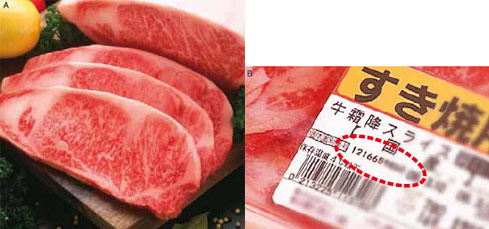
A:Beef containing high-quality fat that allows you to savor umami is called “shimofuri.”
B:With individual identification numbers, traceability applies to all Japanese beef. (http://www.id.nlbc.go.jp/english/)
Fruit
A feast for all the senses
Carefully nurtured appeal both for the eyes and the palate.
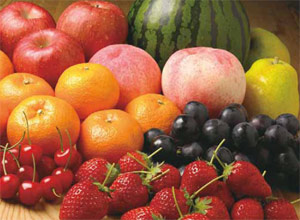 With excellent skill and know-how, growers maximize the delicious qualities of fruit.
With excellent skill and know-how, growers maximize the delicious qualities of fruit.Fruit growers in Japan conduct dedicated research into fruit characteristics and the seasons and base their fruit growing activities on this research. They invest a large amount of time and cost in growing just one final product. For example, they might remove numerous buds from a single branch of a peach, pear of apple tree to ensure that a lot of nutrition goes to just one piece of fruit. By carefully nurturing the fruit through a combination of manual care and knowledge, growers produce fruit that is very juicy and sweet, as if sugar had been added to it.
 |
| Fruit are carefully wrapped one by one to preserve quality and then transported. |
In Japan, the seasons and climate mean that various types of fruit appear at different times. For fruit, the great difference between summer and winter temperatures and the plentiful, quality water produce a delicious taste, juiciness and nutrients. This fruit, which has so fully reaped the benefits of nature, is harvested when judged most suitable by growers. For example, greenhouse melon growers judge peak ripeness on the basis of fruit size, weight, skin pattern and softness as well as stem thickness and leaf luster.
Advanced production and transportation techniques that delight the customer.
To ensure that high-quality fruit is delivered at the best time for eating, growers have introduced techniques that allow them to use laser scanning with computers to assess acid degree, sugar content and weight. Beautifully arranged fruit at their peak of ripeness is also highly prized overseas as gifts.
 |
 |
|
Japanese Tea
Be good to yourself from the inside out
Enjoy this healthy delicious drink anytime, anywhere.

Surrounded by Iush mountains, Japan products fresh,
fragrant green tea.
fragrant green tea.
The astringent constituent in Japanese tea is a type of polyphenol called catechin. There are various types of catechin, and research showing that they work to lower blood cholesterol and moderate fat absorption has attracted attention. Furthermore, the vitamin C in green tea is protected by the simultaneous consumption of catechin so that it is not destroyed by heat, allowing ample vitamin C uptake. It also contains constituents such as caffeine and theanine, which has relaxing properties. While drinking green tea is nutritious, using the entire leaf in food provides even great nutritional content.
A flavor with depth, attracting attention from gourmets worldwide.
Apart from sencha, which is drunk after steaming the leaves, a less astringent tea called gyokuro has become popular among gourmets overseas in recent years. The tea used in Japanese tea ceremony is called matcha. Its leaves are grown without exposure to direct sunlight. They are steamed and dried without being rubbed then stone-ground to a powder. Naturally, matcha is full of catechin and provides health benefits. There has been an increase in the use of matcha in confectionary and cooking overseas, so even more people are enjoying its depth of flavor.

The matcha, or powdered green tea,
in this ice cream gives it a refreshing
finish.
in this ice cream gives it a refreshing
finish.
There are various ways of manufacturing Japanese green tea. In addition to sencha, the most typical Japanese tea, and deep-steamed sencha, which is steamed for twice as long as usual, each variety has its own unique taste and nutritional elements. These include bancha, which uses the hard leaves and stalks after the new leaves have grown, houjicha, which is made from bancha or sencha that has been roasted over high heat, and genmaicha, which blends sencha with brown rice roasted under high pressure. There are a variety of occasions on which each type of tea is drunk. Sencha is drunk after a meal in Japan. It is effective in reducing stickiness in the mouth and also helps prevent teeth from decaying. Tea drinking is suggested for various purposes and occasions which are commonly observed in Japan. Sencha is recommended as a drink before playing sports and also for quenching thirst. With their lower caffeine content, bancha or houjicha can be drunk before going to sleep.
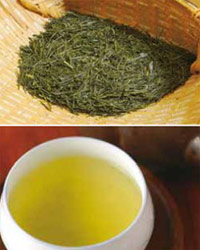 |
Major Nutrients in Green Tea
|
|
Ministry of Agriculture, Forestry and Fisheries
1-2-1, Kasumigaseki, Chiyoda-ku, Tokyo 1100-8950, Japan
TEL: 81-3-3502-8111 (mainswitchboard)
URL: http://www.maff.go.jp/





